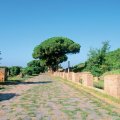Visit this small museum that preserves some of the most beautiful statues found during the excavations.
Allow 2 to 3 hours for an in-depth visit. A cafeteria is open within the archaeological site.
Necropolis. A vast burial zone precedes the entrance to the city. Located outside the city walls, stelae and funerary urns can still be seen.
Porta Romana. The eastern gateway to the city; from here, the Via Ostiense linking Ostia to Rome becomes the Decumanus Maximus, crossing the entire length of the city. Beyond the gate, the piazzale della Vittoria stretches out on the left, a vast piazza adorned with a fountain dominated by the statue of Winged Victory (the original is in the museum).
Neptune's Baths. To admire the Grand Gymnasium and Ostia's finest mosaics (including Neptune and Amphitrite), climb the few steps to the right of the road.
Caserma dei Vigili. Behind the thermal baths, via dei Vigili leads to the Caserma dei Vigili, the "fire station". Admire the beautiful mosaic (the sacrifice of a bull) of the Augusteum, a sanctuary dedicated to imperial worship. On the other side of the baths is via della Fontana, with a fountain featuring a mosaic at the bottom.
Horrea d'Hortense. A central courtyard surrounded by a columned portico, onto which opened the various warehouses(horrea) for storing the countless goods unloaded at the port.
Theater. With a capacity of 4,000 spectators, the theater was probably built during the reign of Augustus, at the instigation of his son-in-law and advisor Agrippa, who was already responsible for many of Rome's public works. From the top of the steps, you can enjoy a beautiful view of the site. Admire the mascarons decorating the backstage area.
Piazzale delle Corporazioni. A true marvel! This vast esplanade at the heart of the city was home to the various guilds of merchants and shipowners active in Ostia. Although the colonnade has disappeared, the mosaic pavements, each featuring the emblems of the various trades, remain. At the center of the square, on a podium, stood a temple dedicated to Ceres or Augustus.
Mithreum of the Seven Spheres. Here are the remains of one of the city's 18 mithreums, dedicated to the worship of the solar god Mithra. This Persian god enjoyed immense success in the Roman world. A statue depicting Mithra sacrificing the bull to regenerate the world (the myth at the root of the cult) is preserved in the museum.
Domus della Fortuna Annonaria , dating from the 3rdand 4thcenturies A.D., was the wealthy residence of a notable; the various rooms of the house overlooking the columned patio can still be seen. The mosaics are fabulous.
Forum baths. The city's largest baths and their public latrines. If you pay close attention, you'll notice the terracotta pipes used to circulate the hot air in the calidarium. A little further on, here are the public latrines, recognizable by the marble benches pierced by some twenty holes. The separation of the sexes was already present at the time.
Forum and Capitol. Continue along Decumanus Maximus to the Forum and Capitolium. On one side stands the Capitolium, Ostia's largest temple. Dedicated to Jupiter, Juno and Minerva, only the brick walls, staircases and two columns remain. It faces the Forum, of which only the remains of the surrounding columns remain.
House of Amor and Psyche, via della Foce, which extends the Decumanus, and on the right, via del Tempio di Hercole. This house boasts a pretty interior garden and remarkable mosaics, marbles and an imposing nymphaeum.
Fishmonger's. Curious, curious, the fishmonger's store is still recognizable by its mosaics depicting seafood, its marble cutting table and its fish tanks!
Insula del Serapide. Now let's retrace our steps to one of the site's most characteristic corners, Via del Tempio di Serapide. In the same street, you can admire the Insula del Serapide (a mosaic with a hunting scene in the circular room of Serapide's house) and, opposite it, the Baths of the Seven Wise Men, with their mosaic paving stones.
Via delle Volte Dipinte. This street leads to the pretty Domus dei Dioscuri, with its polychrome mosaics. Return to the Cardo degli Aurighi, at the beginning of which you turn right onto the Decumanus Maximus, which leads to the Porta Marina, an opening to the sea in Sylla's rampart. Beyond the porta is the tomb of Cartilus Poplicola and the Domus Fulminata.
The scuola di Traiano, where a replica of a statue of Trajan is enthroned. The central hall features a mosaic floor. You then pass the4th-century Christian basilica and arrive at the Bivio di Castrum.
Ostiense Museum (temporarily closed at the time of our last update). On the first floor of a 15th-century building in the heart of the site (once a salt warehouse), this small museum houses some of the finest statues found during the excavations. Not to be missed is the Winged Victory, which once stood at the entrance to the city on the Piazzale della Vittoria, and the exceptionally lively Bull Sacrificed to Mithras. Bustes of emperors and various divinities complete this beautiful ensemble.
Did you know? This review was written by our professional authors.
Book the Best Activities with Get Your Guide
Members' reviews on SITO ARCHEOLOGICO DI OSTIA ANTICA
The ratings and reviews below reflect the subjective opinions of members and not the opinion of The Little Witty.




Find unique Stay Offers with our Partners






